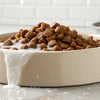Is Raw Freeze-Dried Dog Food Safe? Understanding the Risks and Benefits
- Houndsy
Table of Contents
- Introduction
- What is Raw Freeze-Dried Dog Food?
- Nutritional Benefits of Raw Freeze-Dried Dog Food
- Potential Risks Associated with Raw Diets
- Choosing Safe and Healthy Raw Freeze-Dried Dog Food
- Incorporating Raw Freeze-Dried Dog Food into Your Dog’s Diet
- Conclusion
Introduction
Imagine opening a bag of dog food that smells fresh, looks vibrant, and brims with nutrients—all while being conveniently packaged for easy serving. This scenario is becoming increasingly common as pet owners turn to raw freeze-dried dog food as a nutritious alternative to traditional kibble. In fact, recent studies show that sales of freeze-dried raw dog food have surged by approximately 15% annually, reflecting a growing trend among pet parents in search of healthier feeding options for their furry companions.
But with this increasing popularity comes a critical question: Is raw freeze-dried dog food safe? This blog post aims to explore the safety, nutritional benefits, and potential risks associated with feeding our dogs raw freeze-dried food. By the end of this article, we hope to provide you with the information needed to make informed decisions about your dog’s diet and to analyze whether freeze-dried raw food fits into your pet care routine.
We will cover the following aspects:
- What raw freeze-dried dog food is and how it is made
- The nutritional benefits of raw freeze-dried dog food
- Potential risks associated with raw diets
- How to choose a safe and healthy raw freeze-dried dog food
- Practical tips for incorporating this diet into your dog's feeding routine
As loving pet owners, it’s our responsibility to ensure that our canine companions receive the best nutrition possible. So, let’s dive deeper into the world of raw freeze-dried dog food and uncover what makes it both a popular and contentious choice for our pets.
What is Raw Freeze-Dried Dog Food?
Raw freeze-dried dog food is a unique type of pet food that combines the benefits of raw diets with the convenience of shelf-stable options. In essence, freeze-drying is a process that removes moisture from raw ingredients, thereby preserving their nutritional integrity while making them easier to store and serve.
The Freeze-Drying Process
The freeze-drying process involves several key steps:
- Freezing: Fresh ingredients, such as meats, fruits, and vegetables, are frozen to preserve their state.
- Sublimation: The frozen food is placed under low pressure in a vacuum chamber, allowing the ice to turn directly into vapor without passing through a liquid state.
- Secondary Drying: Any remaining moisture is removed through a secondary drying phase, ensuring the food is stable for long-term storage.
This innovative method retains the taste, smell, and nutritional value of the ingredients, which is a significant advantage over traditional cooking methods that can degrade nutrient content.
Ingredients in Raw Freeze-Dried Dog Food
Most raw freeze-dried diets are composed of high-quality ingredients, including:
- Animal Proteins: Such as chicken, beef, or fish, which are crucial for a dog's muscle health and energy levels.
- Fruits and Vegetables: These provide essential vitamins, minerals, and antioxidants.
- Natural Preservatives: Ingredients like mixed tocopherols help maintain freshness without artificial additives.
The result is a nutrient-dense food option that can support your dog’s overall health.
Nutritional Benefits of Raw Freeze-Dried Dog Food
When it comes to nutrition, raw freeze-dried dog food offers several advantages that can enhance your dog’s diet.
High Protein Content
Raw freeze-dried dog food typically contains a higher protein content than processed kibble. This protein is crucial for:
- Muscle development and repair
- Maintaining a healthy coat and skin
- Supporting immune function
Preserved Nutrients
Because freeze-drying retains the integrity of the ingredients, the nutritional content remains intact. Unlike traditional cooking methods that may diminish vitamins and minerals, freeze-dried food retains vital nutrients, which can lead to better overall health for your dog.
Digestibility
Many dogs find raw freeze-dried food easier to digest compared to kibble. The raw ingredients can be more appealing to dogs, leading to better palatability and consumption.
Versatility
Freeze-dried food can be fed as-is, crumbled over kibble, or rehydrated with water or bone broth, making it a versatile option for picky eaters or those who need variety in their diet.
Potential Risks Associated with Raw Diets
While raw freeze-dried dog food offers many benefits, it also presents certain risks that pet owners should be aware of.
Pathogen Exposure
One of the most significant concerns with raw diets, including freeze-dried options, is the risk of pathogen contamination. Bacteria such as Salmonella and E. coli can be present in raw ingredients, posing potential health risks to both pets and pet owners. Although freeze-drying reduces some pathogens, it does not eliminate them entirely.
Safety Precautions
- Always wash your hands after handling raw freeze-dried food.
- Store the food according to the manufacturer’s instructions to prevent contamination.
- Keep feeding areas clean to minimize the risk of cross-contamination.
Nutritional Imbalances
Not all freeze-dried dog foods are formulated to meet the nutritional guidelines set by the Association of American Feed Control Officials (AAFCO). Some products may lack essential vitamins and minerals necessary for a balanced diet. This is why it's crucial to check for the AAFCO statement on the label before purchasing.
Cost Considerations
Raw freeze-dried dog food can be more expensive than traditional kibble. The freeze-drying process itself is costly, which often translates to higher prices for consumers. Pet owners need to balance their budget with their desire for high-quality nutrition.
Choosing Safe and Healthy Raw Freeze-Dried Dog Food
With so many options on the market, selecting a safe and nutritious raw freeze-dried dog food can feel overwhelming. Here are some tips to guide your choice:
Look for Quality Ingredients
Choose brands that prioritize high-quality, responsibly sourced ingredients. Look for:
- Specific meat sources (e.g., "chicken" instead of "meat by-products").
- Whole food ingredients without fillers or artificial additives.
Check for Safety Certifications
Select products that undergo rigorous safety testing and adhere to high-quality standards. Brands that utilize high-pressure pasteurization (HPP) can further reduce the risk of pathogens while maintaining nutritional integrity.
Consult Your Veterinarian
Before making any significant changes to your dog’s diet, discuss your options with your veterinarian. They can provide personalized recommendations based on your dog’s specific health needs, age, and lifestyle.
Incorporating Raw Freeze-Dried Dog Food into Your Dog’s Diet
Transitioning to raw freeze-dried dog food can be done gradually to ensure your dog adjusts well to the new diet. Here’s how to do it:
Gradual Introduction
Start by mixing small amounts of raw freeze-dried food with your dog’s current diet. Gradually increase the proportion of freeze-dried food while decreasing their regular food over a week or two. This slow transition can help prevent digestive upset.
Monitor Your Dog's Reaction
Observe your dog for any changes in digestion, energy levels, or overall health. If you notice any adverse reactions, consult your veterinarian to make adjustments as needed.
Enjoy the Feeding Experience
Using products like the Houndsy Kibble Dispenser can enhance the feeding experience by providing easy portion control and a stylish design that complements your home decor. It simplifies the process of feeding raw or kibble, making it a breeze for busy pet parents. Explore the Houndsy Kibble Dispenser here.
Conclusion
In summary, raw freeze-dried dog food presents an exciting option for pet owners seeking nutritious and convenient feeding solutions. While it offers many benefits, including high protein content and preserved nutrients, it also carries potential risks, particularly regarding pathogen exposure and nutritional imbalances. By choosing high-quality products, consulting with your veterinarian, and gradually incorporating this diet into your dog's routine, you can make informed decisions that contribute to your pet's well-being.
We encourage you to reflect on your dog’s current feeding regimen and consider whether raw freeze-dried food could be a suitable addition. With the right approach, you can elevate your dog’s nutritional experience while ensuring their safety and health.
FAQs
1. Is raw freeze-dried dog food safe for all dogs? While many dogs can thrive on raw freeze-dried diets, it's essential to consult your veterinarian, especially if your dog has underlying health conditions.
2. How should I store raw freeze-dried dog food? Keep it in a cool, dry place and ensure the packaging is sealed tightly to maintain freshness.
3. Can I mix raw freeze-dried food with kibble? Yes, many pet owners choose to mix raw freeze-dried food with kibble for added nutrition and variety.
4. How often should I feed my dog raw freeze-dried food? Feeding frequency depends on your dog’s size, age, and activity level. Consult your veterinarian for personalized recommendations.
5. What are the signs my dog may not be tolerating raw freeze-dried food? Look for signs of digestive upset, such as vomiting, diarrhea, or changes in appetite. If you notice any issues, consult your veterinarian promptly.
By choosing the right products and following best practices, we can provide our pets with the nourishment they deserve while enjoying the journey together.












